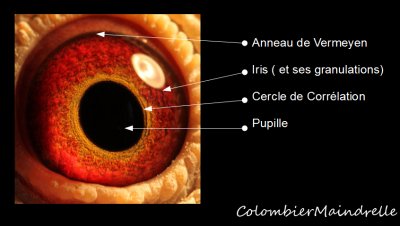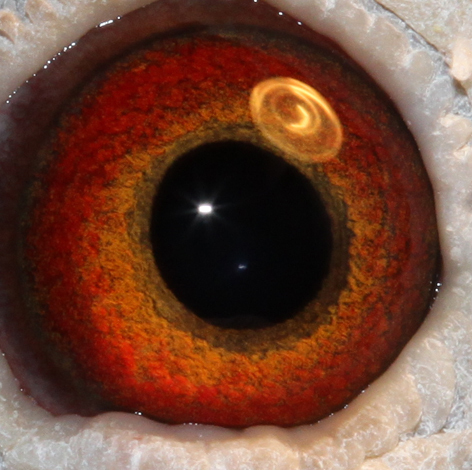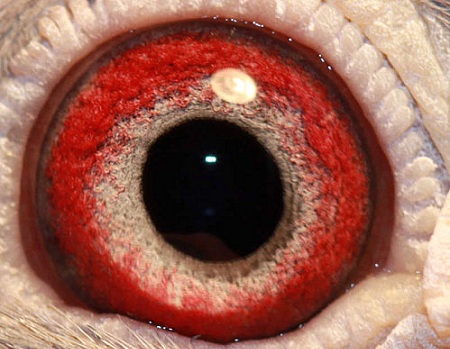If you think that I am going to reveal to you the mystery of the pigeon eye, then you are mistaken. No-one with a pigeon in their hand can see every quality of the pigeon by looking into it’s eye. That is a fantasy. Yet there are some people who can read more things from a pigeon eye than you would expect. This takes considerable practice and after practicing a great deal you gain experience. Allow yourself to be helped by a magnifier which magnifies 15 times. Or get measured for glasses with special magnifying glass. Piet de Weerd uses such glasses when he is examining pigeon eyes. There is no shame or eccentricity then in using such glasses and as the proverb goes: every little bit helps.
The first thing we notice about a pigeon eye, even without optical aids, is the pupil. The pupil is nothing more than an opening in the coloured iris and the deep black is nothing more than a piece of the retina. Images are broken by the lens at the front of the eye and projected smaller onto the retina. The nerve endings present there transmit the images (read: prickles) further to the brain and there the prickles are converted into images: the pigeon sees.
If we assess the eye we can’t ignore the fact that a small pupil is important. A large pupil betrays nervousness and a weak willpower. The more the serious kilometres which have to be flown, the less such pigeons are found at the front when the performances really have to be fought for. That’s why I don’t like to introduce pigeons with large pupils into my stock. They don’t have enough fighting mentality and that is exactly what they need to win big races. The majority of Ace pigeons also have a small pupil. Ace pigeons for me are winners on all fronts between the 100 and 750 km. You find the most big pupils between the good sprint pigeons. Sprint pigeons are not really forced to regularly push themselves to the limit. To fight to the end. Here it is about totally other things: speed, intelligence and of course a great deal of preparation from the trainer-pigeon fancier. Te further the distance, the more the quality of the pigeon has an influence. Without power, supple muscles and mordant, no pigeon wins a race of 650 km with 1100 m.p.m. Small pupils are therefore of great importance to me. When I judge a pigeon eye it is always under the same conditions: at my desk with a halogen lamp for light. Then the conditions are always identical and the eyes can always be judged properly. I regularly move the head of the pigeon away from the light and I don’t like to see the pupils enlarge enormously straight away. Pupils should be small in under any conditions. Pupils which remain the same size I consider to be no good for breeding or racing.
Here you also have the exception to the rule of course, but it is no use being tempted to alter your breeding methods by the exceptions. It would be like leaving all the doors open in case Lady Luck decided to pay a visit. And the chance of that happening is very small, believe me...

The second thing we notice in the pigeon eye is the iris, the ring of all possible colours between the pupil and the colourless which continues under the eyelids. The border is formed by a thin black separating circle which we pigeon fanciers have named after Belgian colleague Louis Vermeyen: the Vermeyen-ring. Let us say it how it is: no clearly defined definition can be given as to how an ideal pigeon eye (read: colour c.q. design of the iris) should look. A lot of personal taste, judgement and intuition comes into play. And every pigeon fancier is free in drawing up his own ideas. I have never made any secret of the fact that I am very charmed by a richly coloured eye, foreseen from the necessary design and depth. The latter is also called pigmentation. And the more pigmentation present in the pigeon eye, the better the eye is foreseen of the nicest colours. A small pupil with deep full colours, housed in a head of the type "owl face", where you can see both eyes when you look directly at the beak, are my favourite apparitions in a pigeon loft. Personality has to radiate from the head. A pigeon has to radiate. Radiate, which is a mixture of intelligence, willpower, experience of life and more such things. It takes years of experience to b able to Judge this well. A breeding pigeon has to have that for me. If she’s clearly not sprinkled with the mysterious elements of ‘something’ then I won’t use such a pigeon for breeding. The experience over the years has taught me that stupid pigeons breed stupid pigeons much easier than clever pigeons produce clever pigeons. Or in other words two donkeys have never produced a racehorse. And once you have introduced a stupid pigeon then it costs years and years to remove that stupidity from your pigeon stock. I am always looking for pigeons with descriptive faces. Faces which give me enough information over the oh so important characteristics for breeding further. How can you learn this so that you can check if your personal taste regarding a pigeon eye is right? By gaining experience at every possible opportunity. It is a matter of wanting to see, to make yourself see!

Eye of the "292", the best racing pigeon of the Louis Maindrelle colony in 2008 & 2009
Take a look in the basket during the basketting for the first races for the youngsters. Then all the types are present. The conditions at the time are still easy. But week after week, once the conditions take their toll at the front of the pigeon peloton, the pigeons with the insipid eyes and expressionless faces disappear more and more.
If you visit a fancier who has specialised in the sprint game, then it is usually the pigeons with the uniform coloured eyes which have the upper hand. If you then visit a grand distance man, you will see totally different eyes: with deep colours and a lot of pigment.
Each type formed and developed for the goal it is meant for. I have had the opportunity to examine the eyes of all types of pigeons in many countries. There was a strong similarity in the eyes everywhere. By the best pigeons they were always full of colour. With this I mean that where there is colour it should be merged together thickly.
There are no clear segregations between the colours, no, they blend over each other freely. The pigmented capillaries of the correlation circle of the circle of adaptation carry on in the coloured part of the iris. There are no defined borders where the rings are concerned. All colour variations ae possible. But then intense from colour from the outside to the inside at the iris. All this is the cause of the pigment of a pigeon. It shows that the blood supply is well regulated to the furthest point of all fibres. This is an important characteristic and I always look for pigeons which have this. You don’t only see it on the eyes, but also on the feathering of the legs.
Pigeon sport is a performance sport. To achieve performances, it is necessary to burn oxygen and energy in the cells. This is then transported through the blood. The better the bloody supply Works, the easier it is for the pigeon to achieve good performances every week. There’s no arguing with that. The blood supply is in direct contact with performance capability. This is reflected in the thick colours in the eyes which is often seen in the best pigeons. In reality, those thick colours are nothing more than accumulatedends of microscopic blood vessels in the iris. The more that can be seen together, the more colour, shades and depth the eye shows.
eye of the "291", a crossing Carlier-Petit x Kipp
Don’t only look at a pigeon eye perpendicular, but also from behind or from front from the side of the beak. Looking from the side allows you to see the rugged surface of the iris better. It should look somewhat granular, that’s what I like best. If you were to put 100 classy pigeons together, then three quarters will definitely answer to what I have written about. Take note: I am talking about classy pigeons, because that’s what our sights are set on aren’t they?? The rest are also good pigeons, but belong to the category exceptions for me. And I have worked out a few times that it would be much cheaper for me to work with inside information than with exceptions. Yet the remaining 25% also performed exceptionally well and that indicates that those pigeons possess enough other characteristics to be able to reach the top of the classifications. And that proves that we shouldn’t only concentrate blindly on one and the same characteristic like most English fanciers do with the there applicable eye theory and so as Vanderschelden who wanted to impress the wing therapy on the fanciers at the time. Take note that every theory is peppered with good elements. They are the icing on the cake, and the more icing on the cake, the more customers will come and eat in the restaurant!
If an eye is filled with those red coloured clouds, then it is a certain indication to the wealth of blood in that eye. This has nothing to do with the granular pigment, but is a result of the very thin blood vessels showing up on the surface. The result is that the iris, which would normally be another colour, now has a blood red colour. Here also I like to see that the colour covers the entire iris. The degree of covering and the characteristic colour displays theblood supply, which again is related to the total blood supply of thewhole body. If the colours and the granularity match the surface of a much used pallete of an artist, then we can presume that everything is well. And that the rest of the blood supply in the rest of the body is the same.
On the whole it gives an indication of the natural form of a pigeon. Of the vitality, which lies at the basis of the performance capability. I like strong eyes which remain the same colour and pigment all year round. That is an indication of the natural vitality. And this belongs to a type of pigeon which is very easy to get into form and keep there.
I stick by the fact that a good blood supply is responsible for a basis vitality and for retaining a constant form during the racing season. The majority of the champion pigeons I am given to judge had strong eyes. Can I say that the majority is in control?? And may I, during discussions, react strongly when the importance of the quality of the eye is dismissed?
The degree of form and vitality depends on the wealth of blood in the total organism. When a pigeon comes into form it is through thesuddenly improved blood circulation in the body. The easiest way to control this is via the eyes. Look at a pigeon which has come home a few days too late after a super tough race. the total organism is extremely tired. Agree?? If you then look into this pigeon’s eyes all the colours have disappeared. Agree?? And then you could logically make the link between the degree of the blood supply to the body and the deep colours of the eyes?? Agree??
And the light grey eyes of the Janssen pigeons then? In principle most of the Janssen pigeons are created for the shorter races. For this, other characteristics are more important. Characteristics so as character, intelligence and speed. These short races are over in the blink of an eye and the pigeons are only in the air for a few hours. In that case issues closely related to the vitality are not of great importance.
We have just discussed the Vermeyen-ring and talked in detail over the pupil and the iris. There just remains the ring which can often be seen between pupil and iris: the circle of adaptation. The circle of authenticity is often grey or black and is full, half or quarter circle. Sometimes in real circle form and sometimes with deep star shaped notches in the iris. Based on the various manifestations, many fanciers are of the meaning that they can derive various characteristics from this. There has been a great deal of discussion over the circle of adaptation. Over the importance. Over the form. And over the colour. And I have to say that there is some truth in this, but also a life-sized falsehood. I that it is more of a pedigree related characteristic. The old De Smet-Matthijs pigeons had this. The Meulemans pigeons to.

But I have held many classy pigeons which didn’t have it. A measure of class or no class is unfortunately not the circle of adaptation then, as such a miniscule indicator of quality or no quality would have been much to easy. True or not?
What many fanciers don’t always notice is the Vermeyen-ring. This ring forms the partition between the colourul outter iris and the rest of the eye which is white in colour. Although it is only a delicate ring, I consider the Vermeyen-ring as an important measure of the form of the pigeon. The colour changes intensity quite a bit, from dark black/brown to light grey or something else. I suspect that as the form rises the Vermeyen-ring becomes a deeper colour. It therefore is a matter of printing the normal condition of each pigeon in your mind, and if something changes it can be a sign that the pigeon is getting in form or losing form. A matter of winning or losing, from racing or staying home. Try it.
Up to now we have looked straight at the iris in each eye separately. That’s what you see most, that’s right. Yet you also have to look at an eye from a different angle, namely from the end of the beak. I like it best when I can see as much of both eyes as possible. This total view gives me a definite impression of the intelligence of a pigeon. Pigeons which don’t have that won’t easily be used by me for breeding. Look and compare it yourself and in the end you will agree with me that this type of pigeon is usually the best.